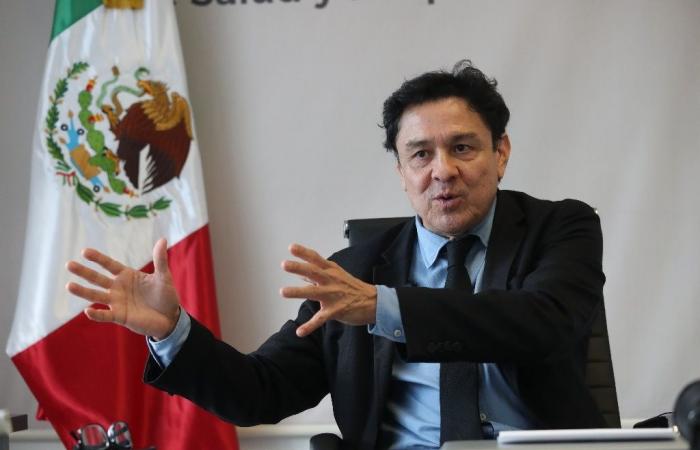We all love Dr. Gustavo Reyes Terán. Seeing him smile at the National Institute of Respiratory Diseases is a relief in itself. Carlos Monsiváis loved him and admired him, although he did not obey him. If he had done it, he would still be among us.
In recent years, his patients have gone to consult him and we stay for a long time beyond the consultation because he always has something new to show us with pride, whether it is the improvement in the hospitalization center or the news in each of the Institute’s pavilions. National Respiratory Diseases. He does it with such enthusiasm and pride that we are moved not only by the medical visit, but by the quality of general medicine that is taught in Mexico, a country of extraordinary doctors recognized worldwide and teaching hospitals to which students from all over America come. Latin and even from the United States and Europe.
–Preventive medicine will always be a pillar of any health system, but in my opinion it should not be exclusive, because when we say that we inherit a completely destroyed health system, we are referring not only to the infrastructure, but to the lack of preventive medicine. Surely you know that heart attack, acute myocardial infarction, is the leading cause of death in the country. About 200,000 people die a year from heart attacks alone, but heart attacks are the final result of the lack of control of a series of diseases that can be prevented…
–Don’t we Mexicans know when something is serious?
–It will take many years to prevent them, Elena. For example, one of the causes of heart attacks is diabetes and nothing is done against the sale of soft drinks and candy to which children are addicted. The incidence of diabetes is increasing, just as the number of people who die each year from an acute heart attack has increased. Now it is more common in young people…
–In the fat ones?
–In large part it is due to overweight and obesity, which has also increased in recent decades, at least in the last 30 or 40 years.
–Is that where the campaigns against soft drinks and sweets come from?
–Yes, but they have not worked because the consumption of soft drinks has increased… Maybe there were campaigns against junk food, but in reality there was never a decrease in a single one of those products and unequivocal proof, a Conclusive evidence of its dimension is that we are the number one or two country in childhood obesity and that is very serious. Mexico is among the first two places for obesity in adults.
–At school dismissal time the candy makers appear like vultures…
–It is catastrophic and it is a problem that has been going on for many decades despite the great doctors who were public health officials in our country, despite the preventive campaigns, despite the promotion of sports, despite the games at recess time…
–Is that why you say that currently the health system is destroyed?
–Yes, when we doctors report it with alarm, we really mean the absence of control and also detection. Nowadays, there is a concept in medicine called the 50 percent rule: 50 percent and 50 percent. In Mexico there is an estimated number of people with high blood pressure or diabetes or with lipid problems (high cholesterol and high triglycerides) that have been detected for several decades, but it is only 50 percent of the total of those people with hypertension or with diabetes or lipid problems. Another 50 percent has not been detected and that is the biggest problem we have to face.
–But 50 percent have already been detected.
–About 75 percent or 80 percent of the total detected receive treatment and of that total only half of them are controlled. In short, of the millions of patients with high blood pressure –which are between 25 and 30 million people in Mexico–, it has been identified only half, and of this, less than half is controlled, that is, we are treating between 15 percent and 25 percent of the total number of people with high blood pressure.
–I don’t understand why it’s so serious…
–It’s crazy, it really is a very serious problem. There are 14 to 16 million people with diabetes in Mexico in total, but we have identified approximately half and we have controlled the other half. In other words, roughly speaking only two out of every 10 people with diabetes are controlled in Mexico. It is very serious. In preventive medicine it would be ideal if there were no diabetes, that there was diet, exercise, gymnastics, aerobic exercises and everything else, that there were no overweight people. For that we have to work precisely, but we will see the results in many years and in the meantime diabetes will continue, which is deadly…
-What are we going to do?
–We must try to identify all people with diabetes, with hypertension, with dyslipidemia, and that our goal is not only 50 percent, but that each year we increase detection by 5 to 10 percent, so that in the following In five or six years we have detected 80 or 90 percent of the total number of people with obesity and diabetes. And not only detect them, but treat them and treat them well.
–Wasn’t the enemy only the covid?
–Obviously, the covid pandemic had a lot of influence in delaying these programs that had been in place for four and a half years. I think that the new government is going to face it and that is when we are going to see better detection and better control of these diseases. The end result is that the number of people with heart attacks will be reduced. The implications of these chronic diseases and their care will increase the life expectancy of Mexicans. In Mexico, in 1960, life expectancy at birth was around 50 years. In the United States and Canada it was a little more, 55 to 60 years, and since 1960 in Mexico it increased with an upward trend. Every year years of life expectancy were gained. Mexico even approached the United States and Canada until 2005; A plateau was created that few people talk about and the trend of increasing life expectancy at birth was lost. In 2005 he was 75 years old. There was a one-year decline in 2011, attributed in part to the war on narcosince before – since Fox and the six-year term of Felipe Calderón – because many young people died in the war against the narco. In 2011 there was a decrease of 75-74 years that was recovered later. But much of this plateau is not only explained by the war against narco, but also due to the lack of control of these three diseases that are like the scourges of humanity and that result in an increasing number of heart attacks: diabetes, hypertension and dyslipidemias that come from cholesterol and triglycerides. Taken together, it explains the plateau until the pandemic arrives in 2019. That one-year decline in 2011 was probably due to the 2009 influenza pandemic, which although not highly lethal, compared to covid it did have final implications. Incidentally, that was the best opportunity that could have been had because the risk factors were identified: diabetes, hypertension, obesity of the people who died (many young people). And in 2009, 2010, 2011 and 2012 there was the opportunity to develop a strategy to face future pandemics that basically consisted of strengthening the first level of care, increasing the number of specialist doctors, especially in Pulmonology, Intensive Care, and Medical Emergencies. , in Internal Medicine, Pediatrics, Neonatology, etc.
What was done in the last four decades, until before this government, was to increasingly restrict medical specialties, which caused many doctors to seek their specialty in private universities, in private hospitals. What the country needed was abandoned, which was not only the first-level infrastructure of health centers in the towns, and clinics adjacent to pharmacies began to flourish. The use of antibiotics that can only be prescribed by a doctor was also restricted. There was an abuse of self-medication and instead of regulating prescriptions for antibiotics, the pharmacies set up adjacent offices at a minimum cost and a serious problem was caused: the abuse of antibiotics. The solution is to strengthen primary care, strengthen second-level hospitals, especially operating rooms, which teacher Zoé Robledo has been doing in the last 18 months, who is doing a great job as coordinator and as director of the IMSS whose structure IMSS Bienestar, formerly called IMSS Coplamar, IMSS Solidaridad, was used to rehabilitate the Mexican health centers that have agreed to adhere to the federalization of the system.






